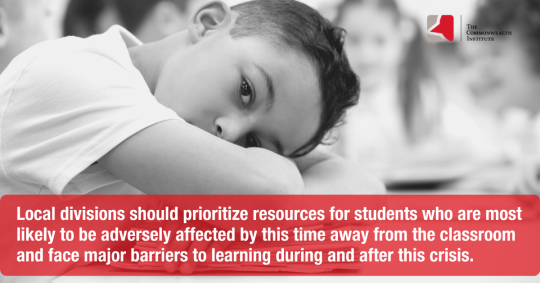May 7, 2020
School Divisions Can Make the Most of Federal Aid to Help Prevent and Respond to COVID Impacts
Every student in every zip code should have access to a high-quality education, yet the pandemic is creating more barriers for some students. Federal aid will be coming to Virginia school divisions through the Virginia Department of Education (VDOE), and local divisions will be deciding how these resources are allocated among their schools and for what services they help fund. Local divisions should prioritize these resources for students who are most likely to be adversely affected by this time away from the classroom and face major barriers to learning during and after this crisis.
The federal aid to state, local, and tribal governments included in the CARES Act is far short of what is needed to address the upcoming budget challenges, especially with recent guidance from the U.S. Department of Treasury limiting use of Coronavirus Relief Fund dollars (one of several major funds in the coronavirus relief package for states and localities). While insufficient, Virginia school divisions will be receiving federal aid through the Elementary and Secondary School Emergency Relief Fund with fairly broad flexibility. Virginia will receive $238.6 million with the majority ($214.6 million) being allocated directly to local school divisions.
(See amounts for each division at the end of this blog post.)
School divisions can use these funds for a wide range of services. These resources can be used for services that include (not complete list):
- activities to address unique needs of children from low-income families, students with disabilities, English learners, “racial and ethnic minorities”, students experiencing homelessness, and youth in foster care;
- mental health services and supports;
- planning and coordinating long-term closures;
- coordination with local health departments;
- purchasing computers or technology to assist with distance learning;
- purchasing supplies to sanitize facilities;
- any activity authorized by the Elementary and Secondary Education Act of 1965.
Note: Recent guidance from the U.S. Department of Education directs local education agencies to make funds available to all students and teachers at both public and participating private non-profit schools under the “equitable services” provision of Title I Part A of the Elementary and Secondary Education Act (ESEA). This interpretation means federal aid could be directed to private schools, regardless of how many students from low-income families they actually serve. It could be particularly impactful in localities that receive a larger share of Title I funding and have higher private school enrollment. Some legal experts question the legitimacy of this interpretation by the Department of Education.
Research tells us that students with disabilities, who are learning English, and/or who are Latinx can face significant barriers to learning from home, and that students in households with low incomes, Black students, and Latinx students experience more summer learning loss when away from the classroom for extended periods of time. We also know that recessions are linked to students of color and students in households with low incomes falling further behind on academic assessments and reducing college attendance among all students. This adds to further harms caused by guardians losing income or employment, which we know from past recessions hits communities of color hardest, and survey data and initial Virginia unemployment claims from this current crisis indicates this will likely be the case again.

The direct funding that school divisions receive from the federal package is based on their share of Title I funding, which broadly reflects the concentration of poverty in divisions. It’s therefore reasonable to assume that this funding should be targeted to students with the most need. VDOE can assist local school divisions by providing clear guidance as to how they can use the $214.6 million to help students who face the most barriers to learning during this crisis. While the state must distribute within one year of receiving funds, school divisions do not have a hard timeline yet for spending the federal support once they receive it. Even so, the year period will allow for in-person remediation for the students with the greatest needs when they return to school. This is important since we know students who are behind academically tend to draw the least benefit from remote learning. VDOE can also use their share (about $24 million) of the federal aid to supplement these efforts further.
There are well documented consequences from school funding cuts that occurred in the aftermath of the Great Recession, both nationally and here in Virginia, showing our highest poverty communities most adversely impacted. While it is clear more aid is needed from the federal government to fully address the budget challenges coming our way, in the meantime, state and local leaders should acknowledge the vast inequities in access to education during this time period, and direct the federal assistance we do have to students who face the most barriers to learning.
| Federal CARES Act Funding to School Divisions | |
|---|---|
| Accomack County | $1,713,822 |
| Albemarle County | $1,268,193 |
| Alexandria | $3,631,222 |
| Alleghany County | $507,039 |
| Amelia County | $288,827 |
| Amherst County | $821,581 |
| Appomattox County | $450,295 |
| Arlington County | $2,065,392 |
| Augusta County | $1,120,251 |
| Bath County | $73,904 |
| Bedford County | $1,288,951 |
| Bland County | $18,647 |
| Botetourt County | $331,218 |
| Bristol | $1,142,302 |
| Brunswick County | $664,211 |
| Buchanan County | $1,210,036 |
| Buckingham County | $580,168 |
| Buena Vista | $210,782 |
| Campbell County | $1,320,251 |
| Caroline County | $751,173 |
| Carroll County | $889,205 |
| Charles City County | $148,234 |
| Charlotte County | $609,305 |
| Charlottesville | $1,204,810 |
| Chesapeake | $6,280,544 |
| Chesterfield County | $5,636,406 |
| Clarke County | $150,408 |
| Colonial Beach | $257,036 |
| Colonial Heights | $504,407 |
| Covington | $209,882 |
| Craig County | $150,675 |
| Culpeper County | $1,239,168 |
| Cumberland County | $390,636 |
| Danville | $3,220,926 |
| Department of Juvenile Justice | $142,983 |
| Dickenson County | $764,673 |
| Dinwiddie County | $668,369 |
| Essex County | $413,665 |
| Fairfax County | $21,088,893 |
| Falls Church | $38,149 |
| Fauquier County | $695,783 |
| Floyd County | $393,774 |
| Fluvanna County | $302,655 |
| Franklin | $626,671 |
| Franklin County | $1,492,694 |
| Frederick County | $1,162,164 |
| Fredericksburg | $881,743 |
| Galax | $494,144 |
| Giles County | $389,205 |
| Gloucester County | $633,644 |
| Goochland County | $255,214 |
| Grayson County | $578,884 |
| Greene County | $362,894 |
| Greensville County | $821,079 |
| Halifax County | $1,324,867 |
| Hampton | $5,873,321 |
| Hanover County | $927,657 |
| Harrisonburg | $1,261,516 |
| Henrico County | $9,293,831 |
| Henry County | $2,128,914 |
| Highland County | $43,541 |
| Hopewell | $1,485,103 |
| Isle of Wight County | $536,830 |
| King and Queen County | $171,617 |
| King George County | $336,541 |
| King William County | $202,411 |
| Lancaster County | $340,612 |
| Lee County | $1,403,765 |
| Lexington | $52,045 |
| Loudoun County | $1,282,208 |
| Louisa County | $783,290 |
| Lunenburg County | $472,088 |
| Lynchburg | $3,311,790 |
| Madison County | $319,528 |
| Manassas | $1,066,318 |
| Manassas Park | $276,815 |
| Martinsville | $939,213 |
| Mathews County | $165,484 |
| Mecklenburg County | $1,187,389 |
| Middlesex County | $295,177 |
| Montgomery County | $1,546,920 |
| Nelson County | $429,945 |
| New Kent County | $217,575 |
| Newport News | $9,605,772 |
| Norfolk | $12,665,679 |
| Northampton County | $595,391 |
| Northumberland County | $412,868 |
| Norton | $220,387 |
| Nottoway County | $701,234 |
| Orange County | $623,388 |
| Page County | $736,593 |
| Patrick County | $567,671 |
| Petersburg | $2,619,380 |
| Pittsylvania County | $1,927,445 |
| Poquoson | $56,090 |
| Portsmouth | $5,336,805 |
| Powhatan County | $236,490 |
| Prince Edward County | $801,046 |
| Prince George County | $534,073 |
| Prince William County | $9,260,966 |
| Pulaski County | $867,332 |
| Radford | $280,586 |
| Rappahannock County | $145,156 |
| Richmond | $13,251,928 |
| Richmond County | $249,707 |
| Roanoke | $5,925,873 |
| Roanoke County | $1,095,848 |
| Rockbridge County | $452,254 |
| Rockingham County | $1,417,685 |
| Russell County | $1,051,083 |
| Salem | $454,471 |
| Scott County | $669,819 |
| Shenandoah County | $965,090 |
| Smyth County | $1,118,607 |
| Southampton County | $495,235 |
| Spotsylvania County | $2,420,334 |
| Stafford County | $1,547,758 |
| Staunton | $703,425 |
| Suffolk | $2,919,033 |
| Surry County | $173,936 |
| Sussex County | $430,346 |
| Tazewell County | $1,471,288 |
| Virginia Beach | $10,110,337 |
| Virginia School for the Deaf and Blind | $75,390 |
| Warren County | $798,326 |
| Washington County | $1,515,256 |
| Waynesboro | $875,533 |
| West Point | $42,322 |
| Westmoreland County | $574,982 |
| Williamsburg-James City County | $1,163,874 |
| Winchester | $959,389 |
| Wise County | $1,837,421 |
| Wythe County | $852,633 |
| York County | $592,236 |
| Source: VDOE release May 1, 2020 |
Category:
Education

